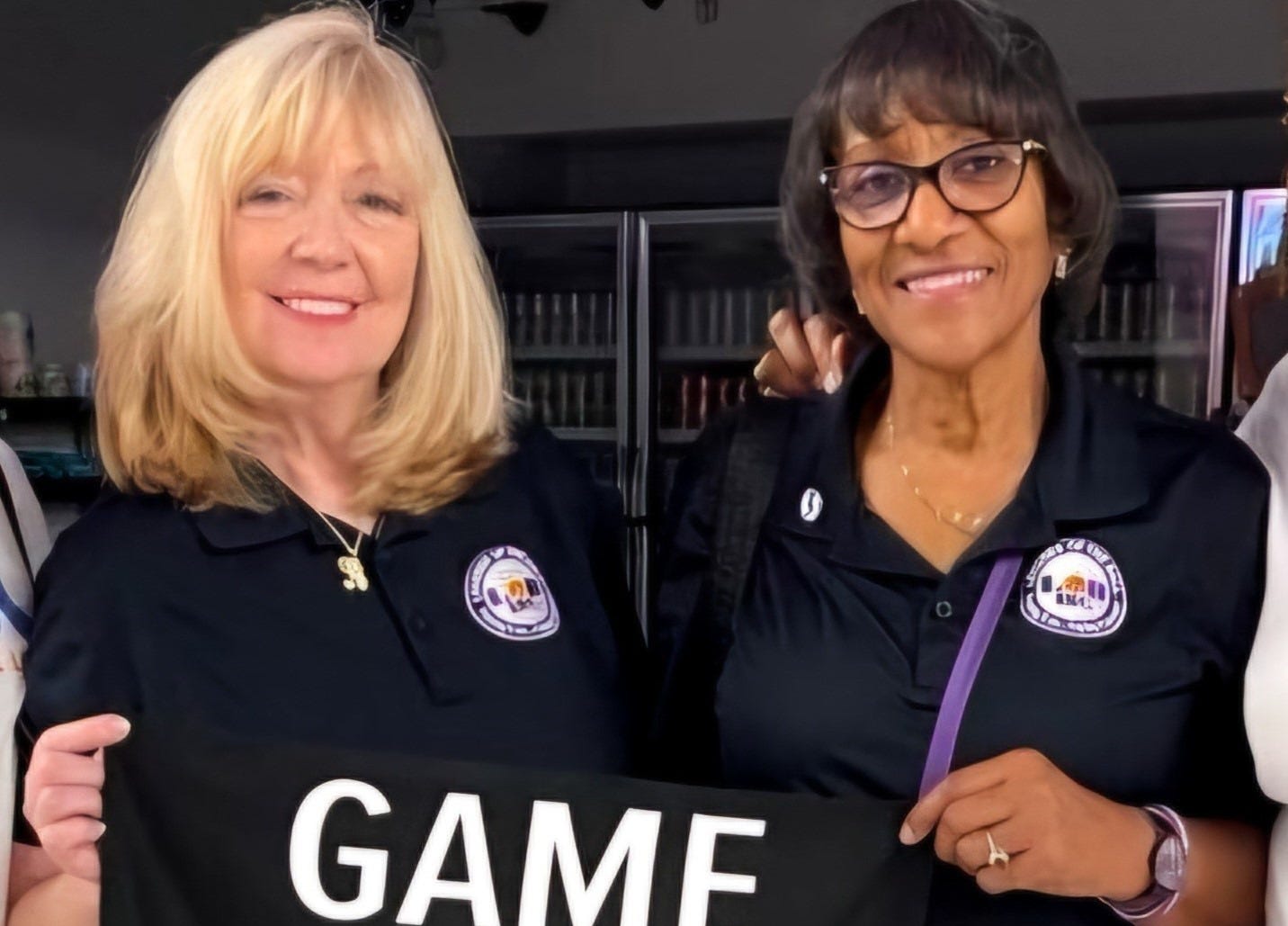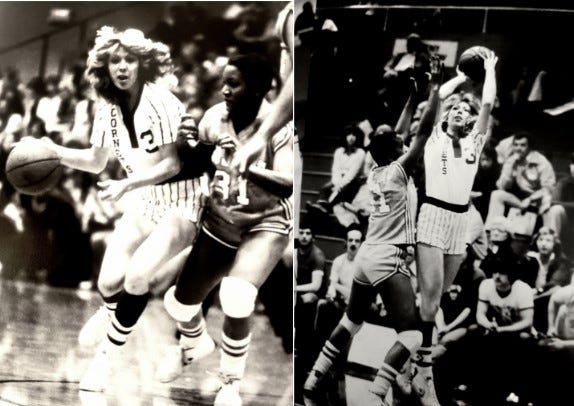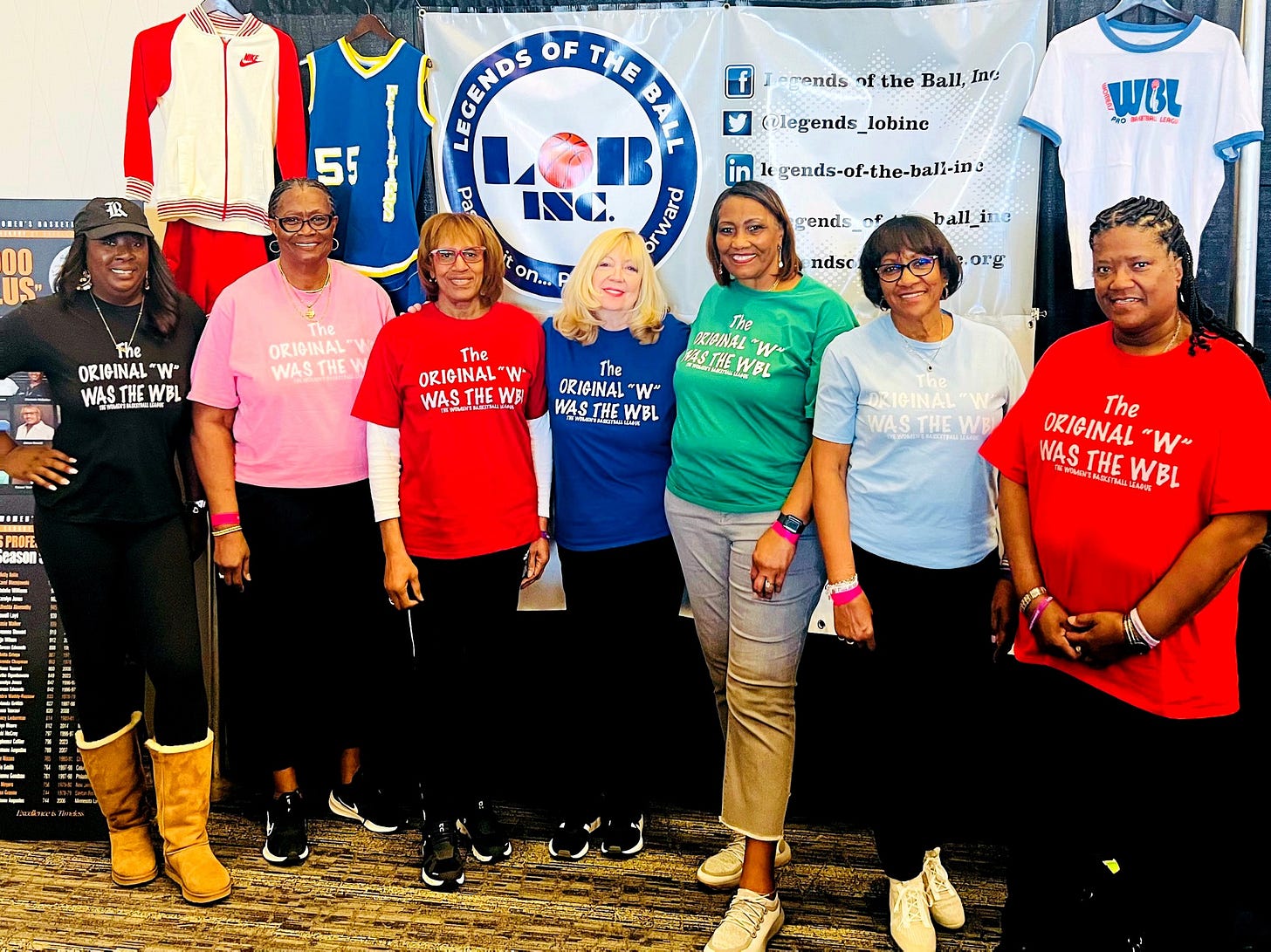Former rivals champion history together
Molly (Bolin) Kazmer and Elizabeth Galloway-McQuitter’s organization works to give pre-WNBA players their due

Molly (Bolin) Kazmer and Elizabeth Galloway-McQuitter once were fierce rivals. Close games. Overtimes. Championships on the line. Galloway-McQuitter, the defensive specialist known as “The Bandit,” trying to stop the scoring juggernaut nicknamed Machine Gun Molly.
So intense was their rivalry in the Women’s Professional Basketball League (WBL), that Kazmer, the Iowa Cornets’ legend, remembers a particularly hard foul by her Chicago Hustle rival that sent the sharpshooter sprawling to the floor.
“One of my teammates hauled me right up and I had to shoot free throws when what I really wanted to do was cry,” Kazmer said with a laugh more than 40 years after the kind of bruising foul that new basketball fans think just started this year in the WNBA.
These days, though, Kazmer and Galloway-McQuitter are on the same team with a shared goal: a legacy that needs to be remembered. As the WNBA just ended its most memorable season, the former rivals are working to steer attention to women’s professional basketball’s beginnings. They are among a group of former WBL players who founded the nonprofit Legends of the Ball in 2018 to work to better organize and communicate the history of not just their league but other eras that paved the way for the college and pro games today.
“I don’t know why we don’t cement it once and for all,” said Galloway-McQuitter, the organization’s president. “You have to acknowledge it, you have to include it. You have to celebrate it and calibrate it and then it’s there as a reference.”
In 2018, the Women’s Basketball Hall of Fame inducted former WBL players into the hall as a group in its Trailblazers section. As more than 100 (of the more than 400 who played) jammed onto the stage for a photo opp and reconnected, it became clear to them that so many stories were going untold – stories of women who just wanted to play basketball and would do whatever it took to get that chance.
“Liz realized if she didn’t start something, we were never going to cement the WBL and the timeline of women’s basketball history,” said Kazmer, LOB’s vice president.
Though the group has been around for six years, the timing now is excellent, too. Women’s basketball is drawing a whole new crop of fans, many who knew little of the college game or even the WNBA until this year. Now, LOB can tap into a new audience of curious fans along with others who don’t know what existed before current events.

The WBL launched in 1978 and played for three seasons, folding in 1981 because of financial problems. But along the way, the league showed that fans would come to watch women’s pro basketball, as several teams had good crowds. Some got media coverage; WGN showed Chicago Hustle games. The league was innovative: It introduced the smaller ball that is now standard for women’s basketball.
Kazmer, a high-scoring player from Moravia, Iowa, and Grand View College, was the league’s first player to sign, getting a $6,000 contract to play for the Iowa Cornets. Galloway-McQuitter played all three seasons for Chicago after a college career at Nevada-Las Vegas.
Players from that era were more than just the first pros, Galloway-McQuitter emphasizes.
“We were the first to play professional basketball, we were the first to play in the Olympics, we were the first to get scholarships after Title IX, we were the first all-Americans,” she said. “We call ourselves the generation of firsts.
“That means because we came along at that special time and programs were starting up, we were the first ones to step through those doors and we’ve kept those doors open ever since.”
LOB representatives travel to make presentations to students, coaches, teams and organizations to get the word out. The group also raises funds for scholarships and for the goal of creating an inclusive digital timeline of women’s basketball throughout the decades.
“We want to be in the places that house history,’’ Galloway-McQuitter said. “We’re already in the Women’s Basketball Hall of Fame, we want to be in the Naismith Hall of Fame.”
Caitlin Clark’s record-breaking college career was a perfect example of not knowing the game’s history, Galloway-McQuitter and Kazmer said. Clark’s march to the NCAA scoring title was couched by the media and others as a move up a chart that included players such as Kelsey Plum and Jackie Stiles but ignored others.
“It really brought out the fact that they’d overlooked Lynette Woodard of the AIAW,” Kazmer said of the former Kansas star. “It was awesome that they brought her out and celebrated her.”
The Association of Intercollegiate Athletics for Women was the first governing body for women’s sports after Title IX passed in 1972. The AIAW folded after the NCAA took over governance of women’s sports for the 1982-83 season. Both Woodard and another player who some still consider the all-time scoring leader, Hall of Famer Pearl Moore, played in the AIAW years.
It also frustrates Galloway-McQuitter that men’s basketball knows and carries its history well. Watch a game and there might be easy references to Bill Russell, George Mikan or Jerry West. Yet so many names from the women’s game go unspoken.
“You can’t start with the WNBA, you can’t start with the NCAA,” she said. “I want [ESPN’s] Carolyn Peck or Andraya Carter, when they’re sitting there talking and the opportunity presents itself, to pull in history. It’s so easy to do, I do it all the time when I’m watching.”
The WBL featured the best players of the era, though some delayed entry into the league to remain amateurs in order to qualify for the ill-fated 1980 Olympic team. The names weren’t as well-known as pro players might be now because the college game hadn’t fully developed. Even so, the three-year WBL roster includes nine Olympians and 20 Hall of Famers. Beyond legends such as Ann Meyers and Nancy Lieberman, the league also included future Notre Dame and NCAA championship coach Muffet McGraw and future WNBA commissioner Donna Orender.
“Molly is the one who is missing,” Galloway-McQuitter said of the basketball halls of fame. “You have all these WBLers in there but you don’t have one of the most dominant players in the league. She’s the last one who is an absolute must to get in the Hall of Fame.”
Kazmer didn’t win a championship in high school or college but became a superstar as a pro. She averaged 32.8 points a game and scored 55 points in a 1980 game against the Minnesota Fillies. She was the league’s co-MVP (with Meyers) for the 1979-80 season. The 1,179 points she scored that season still tops the list of most points scored in a women’s pro basketball season. This past WNBA season, the Las Vegas Aces’ A’ja Wilson scored 1,021 to set a WNBA record. (Kazmer scored the points in 36 games, Wilson 38.)
“Liz speaks up for me in a way that no one else does,” Kazmer said. “Given the way I grew up, I’m not someone to toot my own horn and talk about how great I am. It’s amazing to have someone who saw me play and believes in what I accomplished.”

Having Galloway-McQuitter champion Kazmer is an ironic twist for the former rivals. Through LOB, the two have become close friends but that certainly wasn’t the case in their playing days.
“We did not like each other,” Galloway-McQuitter said. “Our teams did not like each other.”
WBL players were recognized and celebrated at this season’s WNBA All-Star Game in Phoenix. Kazmer said they were surrounded by people who wanted to talk to them and get photos, so many that they stuck around long enough to be shooed out of the arena. Then photo opps and fan conversations continued outside.
“It was an amazing night,” Kazmer said. “Once they knew who we were they were inspired by it.”
Maybe that means that LOB’s mission is beginning to succeed, that more people are realizing the WBL existed and that the players are still around to tell the stories.
“We look at the players [now] and we see ourselves in them,” Galloway-McQuitter said. “They carry our dreams inside but they don’t know our names. They continue to soar but don’t know who gave them wings. They continue to reach new heights but don’t know the source. That’s how we feel.
“We were once them.”
For more information on the WBL era of basketball: The book “Mad Seasons” delves into the league’s history; a biography of Molly (Bolin) Kazmer was released in 2019, “The Legend of Molly Bolin”; my Iowa Writers Collaborative colleague Dan Finney wrote a fantastic Molly Kazmer profile in the Des Moines Register in 2020; the Legends of the Ball website; a recent Houston Chronicle story tells the story of the Houston Angels, the WBL’s first champion; earlier this year I wrote about an effort to make a documentary series about women’s basketball history.
Jane Burns is a former sports and features writer for the Des Moines Register, as well as other publications and websites. She’s a past winner of the Women’s Basketball Coaches Association’s Mel Greenberg Award for her coverage of women’s basketball. Over the course of her career she’s covered pretty much everything, which is why her as-yet-to-be-written memoir will be called “Cheese and Basketball: Stories From a Reporter Who Has Covered Everything.”
I’m happy to join fellow Iowa writers and journalists as part of the Iowa Writers’ Collaborative. The collaborative is 60 writers throughout the state - likely some familiar names to Iowa readers - publishing on topics ranging from politics to food to sports and so much more. A subscription (paid or free) gets you a Sunday roundup of all the writers’ work that week. One of my colleagues described it as “Iowa’s Sunday newspaper.”
Meet the writers here, and see for yourself the great variety the collaborative offers.





Great story! We moved to IA in the summer of 1976. Molly Bolin was the first name we read about in the DM Register in our early Iowa years. What a performer!